Revision Notes: Pressure In Fluids And Atmospheric Pressure | Physics Class 9 ICSE PDF Download
Thrust and Pressure
- Thrust is the force acting perpendicularly on an object.
- It is a vector quantity. Its SI unit is newton (N).
- Pressure is the force or thrust acting perpendicularly on a unit area of the object.
Pressure = (Thrust/Area) = F/A - The same force acting on a smaller area exerts a larger pressure and on a larger area exerts a smaller pressure.
- The SI unit of pressure is N/m2. This unit is named as pascal (Pa).
- One pascal is the pressure exerted on a surface of area 1 m2 by a force of 1 N acting normally on it.
Pressure in fluids
- A substance which flows is called a fluid.
- Fluids exert pressure on the base and walls of the container in which they are enclosed.
- Pressure exerted in any confined mass of fluid is transmitted uniformly in all directions.
Pressure Exerted by a Liquid Column
- The pressure on a surface at a depth ‘h’ is

- The total pressure inside a liquid column at a depth is the sum of the atmospheric pressure on the liquid surface and the pressure due to the liquid column.
Total pressure = P0 + hρg
Laws of Liquid Pressure
- Pressure is the same in all directions about a point in the liquid.
- In a stationary liquid, the pressure is the same at all points on a horizontal plane.
- Pressure at a point inside the liquid increases with depth from the free surface.
- Pressure at the same depth is different in different liquids. It increases with increase in density.
- A liquid seeks its own level.
Some Consequences of Liquid Pressure
(i) The wall of a dam is made thicker at the bottom.(ii) To supply water to a town (or a colony), the water supply tank is placed at a sufficient height.
(iii) Deep sea divers need to wear a special protective suit. In the deep sea, the total pressure exerted on the diver's body is much more than his blood pressure.
Pascal’s law
- Pascal's law: The pressure exerted anywhere in a confined liquid is transmitted equally and undiminished in all directions throughout the liquid.
Application of Pascal’s law
- The hydraulic press, hydraulic jack and hydraulic brakes work on Pascal’s law of transmission of pressure.
Examples of Hydraulic Machines
Hydraulic Press (Bramah Press):
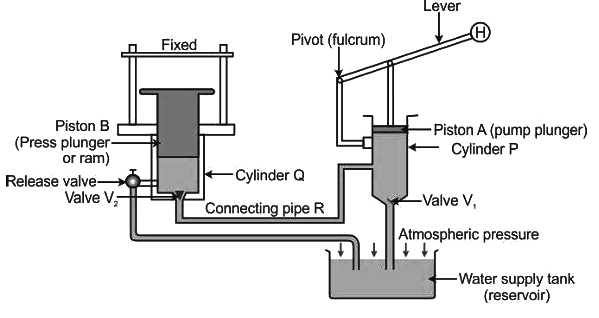
Uses:
- For engraving monograms on books.
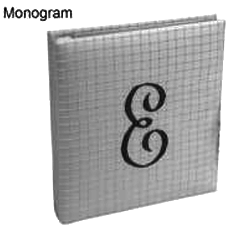
- For extracting juice from sugarcane.
- For squeezing oil from linseed and cotton seeds.
- For pressing cotton bales and goods, quilts, books etc.
Hydraulic jack:
A hydraulic jack is used to lift heavy vehicles at service stations for repair works.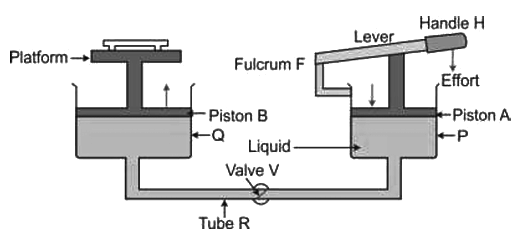
Hydraulic brakes: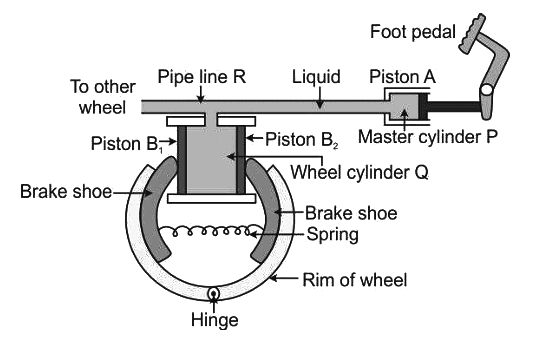
Atmospheric Pressure
- The envelope of air surrounding the Earth is called the atmosphere.
- The thrust exerted per unit area of the Earth’s surface due to a column of air is called the atmospheric pressure on the Earth’s surface.
- Its value is about 1 kgf/cm2 = 105 N m-2 = 105 Pa.
- We do not feel this large amount of thrust as our blood pressure balances this thrust.
1 atm = 0.76 m of Hg = 76 cm of Hg =1.013 x 105 Pa
Consequences of Atmospheric Pressure
- We can suck a drink with a straw
- We can fill a syringe with the liquid
- We can fill ink into a fountain pen
- Rubber suckers work due to atmospheric pressure
- Action of a siphon system is based on atmospheric pressure
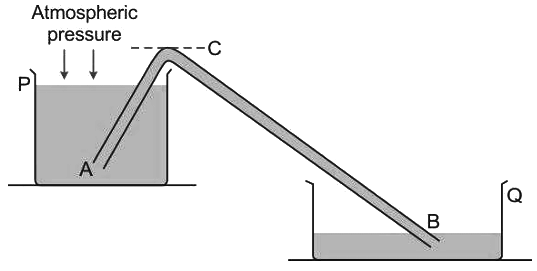
Measurement of Atmospheric Pressure
- Atmospheric pressure is measured using a barometer.
Simple barometer: Torricelli first designed a simple barometer using mercury as the barometric liquid.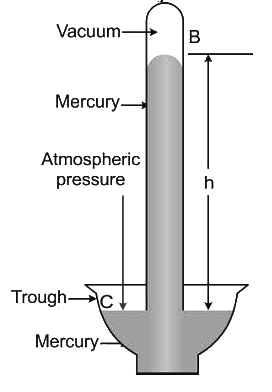 Advantages of using mercury as a barometric liquid
Advantages of using mercury as a barometric liquid
- The density of mercury is greater than that of all other liquids, so only 0·76 m height of the mercury column is needed to balance the normal atmospheric pressure.
- The vapour pressure of mercury is negligible, so it does not affect the barometric height.
- The mercury neither wets nor sticks to the glass tube. Therefore, it gives the correct reading.
- The surface of mercury is shining and opaque. Therefore, it is easily seen while taking the observation.
- It can easily be obtained in the pure state.
Disadvantages of using water as a barometric liquid
- The density of water is low, so nearly 10·4 m height of the water column is needed to balance the normal atmospheric pressure. It will be very inconvenient to use a tube of height 10·4 m for a barometer.
- The vapour pressure of water is high, so the vapours in the vacuum space will make the reading inaccurate.
- Water sticks to the glass tube and wets it, so the reading becomes inaccurate.
- Because water is transparent, its surface is not easily seen while taking the observation.
Defects of a simple barometer
- There is no protection for the glass tube.
- The surface of mercury in the trough is open; therefore, there are chances that the impurities may fall in and get mixed with the mercury of the trough.
- It is inconvenient to move the barometer from one place to another.
- A scale cannot be fixed with the tube (or it cannot be marked on the tube) to measure the atmospheric pressure.
Fortin’s barometer: It is a modified form of a simple barometer. It is used in the laboratory to measure the atmospheric pressure. It also uses mercury as barometric liquid.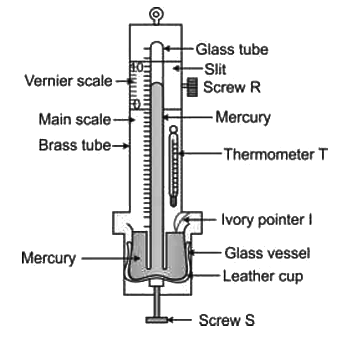
Aneroid barometer: This barometer does not have a liquid. It is light and portable. Hence, it can easily be carried from one place to another. It is calibrated in such a way that it reads the atmospheric pressure directly.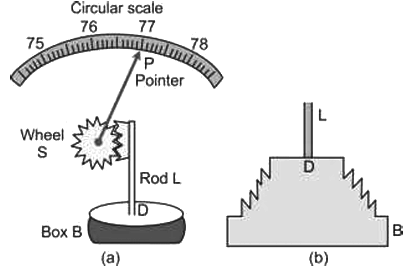
Uses of a barometer
- To measure the atmospheric pressure at a place
- For weather forecast
- As an altimeter
Variation of atmospheric pressure with altitude
- The pressure of air decreases with increase in altitude.
- The decrease in atmospheric pressure is due to
- Decrease in height of the air column which causes a linear decrease in atmospheric pressure.
- Decrease in density of air which makes the decrease in atmospheric pressure less rapid with increase in altitude.
- The following graph shows the variation of atmospheric pressure with height above sea level.
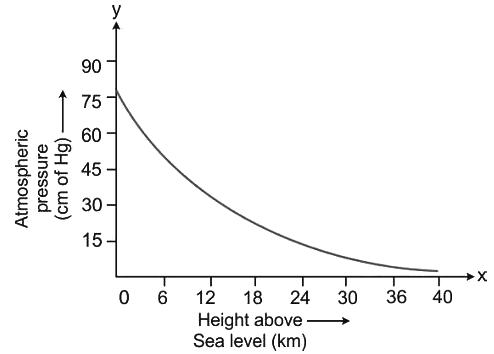
- Consequences of travelling to high altitudes
- The air pressure reduces and hence breathing problems occur. Also, the nose may bleed.
- A fountain pen will start leaking due to the pressure difference at a high altitude compared to the air pressure on the surface.
Weather Forecast by a Barometer
A weather forecast is done as follows:
- If the barometric height at a place falls, then it means that the pressure at that place has fallen, indicating the coming of a storm or cyclone.
- If the barometric height gradually falls, then it indicates that the moisture is increasing, i.e. there is a possibility of rain.
- A gradual increase in the barometric height means that the moisture in the air is decreasing. This indicates dry weather.
- A sudden rise in the barometric height means a flow of air from that place to surrounding low pressure areas. This indicates extremely dry weather.
- If there is no abrupt change in the barometric height, then it indicates that the atmospheric pressure is normal, i.e. the weather is fair.
Altimeter
- An altimeter is a device used in an aircraft to measure its altitude. Because the atmospheric pressure decreases with the increase in height above the sea level, a barometer measuring the atmospheric pressure can be used to determine the altitude of a place above the sea level.
- An aneroid barometer which has the scale calibrated in terms of height of ascent can be used as an altimeter.
- The scale of an altimeter is graduated with height increasing towards the left because the atmospheric pressure decreases with increase of height above the sea level.
|
9 videos|63 docs|10 tests
|
FAQs on Revision Notes: Pressure In Fluids And Atmospheric Pressure - Physics Class 9 ICSE
| 1. What is the principle behind Fortin’s barometer? |  |
| 2. How does an aneroid barometer work? |  |
| 3. What are the units of measurement for atmospheric pressure? |  |
| 4. Why is atmospheric pressure important in weather forecasting? |  |
| 5. How does pressure in fluids differ from atmospheric pressure? |  |
















